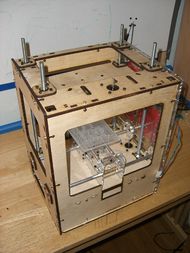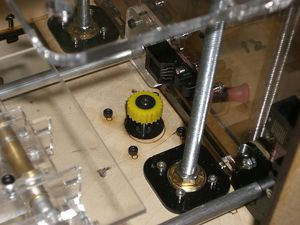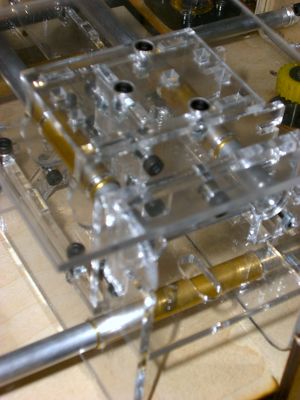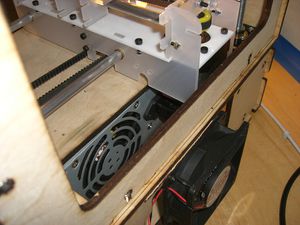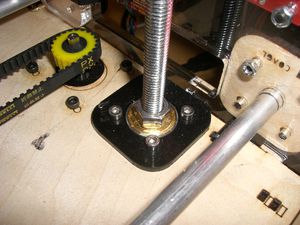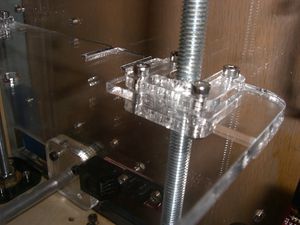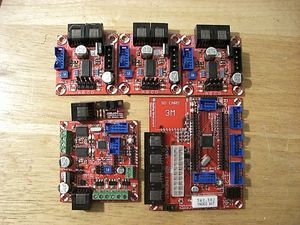Pirated CupCake
Release status: unknown
| Description | Cupcake as RepStrap
|
| License | |
| Author | |
| Contributors | |
| Based-on | |
| Categories | |
| CAD Models | |
| External Link |
CupCakeStrap Basics:
True DIY should be done on the lowest operating budget possible
The CupCakeStrap is the high-school Senior Project of Benjamin Rockhold and Griffin Nicoll. It is a CupCake made from as close to scratch as possible, with the excepton of PCBs, Steppers, and PSU. Everything else was purchased in individual components from "The Internet" and a few local hardware stores. The plastic and plywood parts were laser-cut with Roosevelt High School's laser cutter and free material from donation. The CupCakeStrap is different from normal CupCakes in that it has been modified to reduce the price of some important parts, and it is not intended as a final machine. Instead, it will serve to print out parts for its successor, a RepRap Mendel-derivative (similarly modified for low cost). Thus, it is a RepStrap in spirit and a CupCake derivative in body.
Contents
So, I bet you're asking "What's the attraction to building a Cupcake, with its smaller print area, high price, and odd naming?" Well, first off, it's the cutest of printing machines. Secondly, if it's not going to be purchased outright from Makerbot, it's really not very expensive at all. I'm not trying to say that the machines Makerbot sells are not excellent or are over priced, but the draw to make one from scratch is pretty strong.
The following is basic documentation, not in any real organized form. This is a to-do item :p
CupCakeStrap Hardware
All of the Hardware variations from the original CupCake.
Improvisions Made for Low-Price
We decided that in order to maintain a low price, we ought to custom-build more parts than we have to order in a completed state. Basically, these modifications were made anywhere we thought we could save a buck without reducing functionality.
Acrylic Pulleys
To produce pulleys for zero cost, we found random belts from a scrapped printer (a BIG one, new printers use really small and useless belts) that looked similar to the ones used on the real CupCake, and then measured them. Using Inkscape, we performed a rotation of the tooth profile into a circle, and modified it to work with warping and stretching. Then we just lazzored them out of thin acrylic, and fused the layers together with an acrylic solvent. To attach to the motor, we used some random rubber things from the same printer, used to move paper. The rubber is a short tube, and very stiff. It was about 10mm in external diameter, and about the same as our motor's shaft in internal diameter. We insert the tube into the pulley, then press it onto the motor shaft. It's way, way stronger to hold in place than the motor can torque.
Cheap Linear Bearings
Rather than buy "real" linear bearings, we picked up some M8 Aluminum rod ($3 per meter) and some 8mm internal diameter brass tube (30cm for $4). With this, you get a sub-$10 brushing. We cut 6cm lengths of the brass tube and inserted them into a modified X stage (bearing holes reduced to diameter of brass rod). We made 3.5cm lengths for the Y stage, modified the same way.
Improvisions Made for Increased Functionality
Now and then in the build process, we found things that we thought could be improved from the original CupCake. These are not particularly critical to the machine, but make it look better or work better (open to interpretation).
Motor Cut-Out
The motors we ordered (from Ebay) were more than 1cm longer than we expected, and so the Y-Stepper that rides the X-Carriage was too long to fit in the room given to it. We cut a large rectange out of the middle platform to correct this, and furthermore had to slide the PSU further forward in the machine. This means the PSU is 8cm in from the back plate. We have secured it with packing tape.
Extra Bearing Holders
The original CupCake has bearings on the bottom end of the Z-Stage rods that stick up from the 4mm plywood used. These look kinda bad, so we added an extra few mm of acrylic cut to fit the bearing and to resemble the Z-Stage bearing capture layers. These extra layers are essentially cosmetic, but they also make it harder for the bearing to escape its hole. Theoretically, they could be augmented with a bearing-capture layer, and this would make the upper capture layers unnecessary. That might look nice.
Z-Platform Nut-locks
We decided that allowing the nuts to come lose from the Z-Stage was not something we wanted to see, even in the event of a head-crash. We added two more layers to the nut holder to fully trap it, a layer that mimics the platform's shape, and another Z-Guide part. We are going to have to modify the extruder-holding dinos to release the head in event of a crash, but that is a to-do item.
CupCakeStrap Electronics+Software
Not too many modifications were made to the electronics for the CupCakeStrap, but it has an interesting history and mix of parts.
Electronics
The CupCakeStrap was originally designed around the RepRap Generation 3 electronics, build by hand from components ordered from Mouser and Digikey. A number of supply issues caused the Stepper Drivers and Extruder controller to lose their 5v Linear Regulators, and the Motherboard lost its SD Card slot. The card slot was ignored, but the linear regulators proved hard to work around. A solution whereby we tapped the unused 5v supply from the PSU was proposed on the RepRap IRC, and this solution worked! By taking 5v from the ATX jack and feeding it to the output pad of the stepper boards we were able to operate the boards. However, we lost one stepper board to a faulty resistor and diode. This board was replaced with a borrowed 1.2 board with cooling issues. After finally getting everything running, the CupCakeStrap performed two "prints," with no toolhead. However, on the third power-on one of the remaining 2.3 stepper boards began emitting ozone and shortly after a capacitor began sparking and then detonated with a puff of smoke and flame. We believe this board to be now inert, but intend to test it with a replacement soon. The single remaining stepper 2.3 board will have the 5v line removed, and is waiting on a linear regulator.
As a replacement, we have ordered three new stepper boards from Techzone. These have not yet been counted into our price, as we have not decided if the accidental damages should be counted into the CupCakeStrap's price. They will probably not, as they are not needed if the original boards survive.
Software
While technically programmed as a cupcake right now, we plan to get it running with reprap FiveD firmware, although as of writing this has not gone successfully.
Price-Comparason
Our CupCakeStrap has, to date, cost less than $300. Compared to the CupCake's $750 price, this is pretty significant.
Original CupCake Price Breakdown:
The makerbot's $750 base price is just for:
- laser-cut plywood and laser-cut plastic = $200
- 3 NEMA 17 stepper motors and one big gearmotor = $75
- Nichrome wire, PTFE tube, and a milled barrel and nozzle ~ $30
- The reprap-derived electronics for controlling it. = $200
- Nuts, bolts, bearings, pulleys, metal rods and brushings and assorted metal parts, including some magnets ~ $250
- 1lb of ABS ~ $20
- Belts = $???
- M3 and M8 Allen keys = $???
You should note that those prices are what you would pay Makerbot for the individual items (as of march 31st), and do not properly represent their market value. It also totals more than $750.
The "deluxe" version adds $200 for the following:
- Some more laser cut plastic
- An ATX powersupply (like in a desktop computer)
- A USB to TTL cable to interface with it
- The cables that you need to connect the machine up it its own parts
- 5lbs more ABS
- Hex keys, wrenches, and some metal parts
- An SD card.
(Prices attached only where I could determine their actual cost)
Now, that's a respectable list, and probably worth every penny to someone who does not already have any of those items. However, if you are in a position to use or borrow any of those things, the price becomes a lot less appetizing. Thus, it is a good idea to treat the machine as a RepStrap, and not worry about building an exact clone of the Master CupCake in whose likeness all other CupCakes are forged.
CupCakeStrap Price Breakdown
The CupCakeStrap was built using a lot of scavenged parts, things that were laying around, and a huge quantity of freely available acrylic sheeting. This was especially useful as it meant we could simply laser cut a new part whenever a measurement was wrong. For example, we now have three complete sets of XY stage plastic and about a million failed pulleys.
- Laser-Cut plywood and acrylic = $0
- Belts = $0 (from scrapped printer)
- PSU = $0 (from scrapped computer)
- 3 NEMA 17 stepper motors and one big gearmotor = $35 (Ebay and a free gearmotor)
- Nichrome wire, PTFE tube, and a milled barrel and nozzle ~ $30
- Nuts, bolts, bearings, metal rods and brushings and assorted metal parts ~ $100
- RepRap Gen-3 PCBs ~ $20
- Electronics Components ~ $120
- A USB to TTL cable to interface with it = $3 (Nokia phone cable, bought from Ebay and hacked)
- An SD card. = $0 (did not actually buy a slot for one, so there is none.)
Total ~ $253 This is a pretty rough estimate, pulled from my head. Probably less than this, but unsure.
Related Projects
The Original Makerbot CupCake CNC and the RepRap concept RepStrap.
Design Files for CupCakeStrap
Essentially, these are modified Makerbot CupCake design files, with extra bits added and some assorted parts removed. If I could go back and re-do the machine, I would. Sadly, our supplies of time are too low for that right now.
Downloads
Incoming... Slowly. Files may or may not be actually useful.
